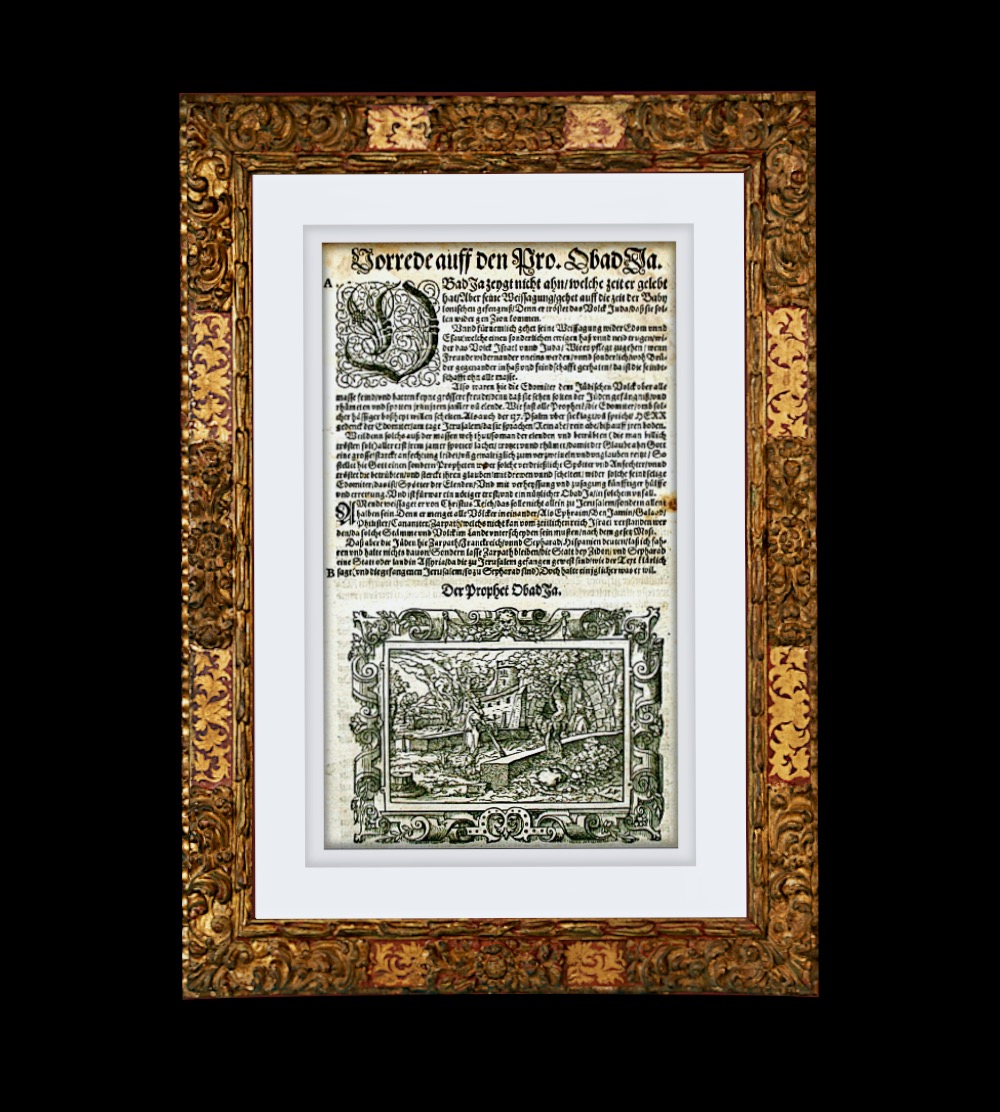

Title: Original 17th Century Lutheran Bible Book Page Print Art Engraving
Shipping: $29.00
Artist: N/A
Period: 17th Century
History: Art
Origin: Central Europe > Germany
Condition: Museum Quality
Item Date: 1650
Item ID: 3671
This page is from a Lutheran Bible, hand-printed around 1650, making it a valuable artifact from the 17th century. The collection primarily consists of prints and drawings with popular imagery, reflecting the artistic trends of the 16th and 17th centuries. Only one page from this particular book has survived. The page is a captivating two-sided engraving and letterpress composition. In the evolution of printed materials, the title page began to serve as a promotional and marketing tool. This specific example, with its longer title, exudes a sophisticated charm not present in earlier versions. During this era, printers sought ways to appeal to a broader audience while keeping production costs in check. One approach was to print a single book in multiple languages rather than creating distinct editions, leading to instances where separate title pages were produced. It's worth noting that early printed books often mirrored the format of manuscripts and lacked title pages. The introduction of letterpress printing, a method utilizing a press with a "type-high bed" and movable type, revolutionized the process. In this technique, a raised surface is inked and pressed into paper to create a positive, right-reading image.
The history of Lutheran Bible engravings and typesetting is a fascinating journey through the evolution of printing technology and artistic expression. Let's delve into the key milestones and characteristics that define this rich history. 1. Early Manuscript Influence: In the early days of printing, particularly in the 16th century, Lutheran Bibles often retained the visual characteristics of handwritten manuscripts. These early printed books lacked title pages and were adorned with intricate handcrafted illustrations and decorations. 2. Emergence of Letterpress Printing: The introduction of letterpress printing marked a significant shift in the production of Lutheran Bibles. This relief printing method involved a type-high bed and movable type. The reversed, raised surface was inked and pressed onto paper, allowing for more efficient and consistent reproduction of text and images. 3. Rise of Engravings: Engravings became a prominent feature in Lutheran Bibles during the 17th century. Skilled engravers meticulously carved illustrations onto metal plates, which were then inked and pressed onto the pages. These engravings often depicted biblical scenes, religious symbols, and intricate designs, contributing to the visual richness of the Bibles. 4. Promotion Through Title Pages: As printing technology advanced, title pages began to play a crucial role in marketing and promotion. Lutheran Bibles started featuring elaborate title pages with detailed engravings and sophisticated typesetting. These pages not only conveyed information about the content but also served as aesthetic showcases. 5. Multilingual Printing Practices: To cater to a broader audience and manage costs effectively, printers sometimes opted for multilingual printing. Instead of producing distinct editions for different languages, a single Bible would incorporate various languages, accompanied by separate title pages for each language. This practice showcased the versatility of typesetting capabilities. 6. Evolution of Imagery: The imagery found in Lutheran Bibles evolved over time, reflecting changes in artistic styles and religious sentiments. From intricate engravings illustrating biblical narratives to symbolic representations of theological concepts, the imagery on these pages provides a visual chronicle of Lutheran religious expression. 7. Preservation Challenges: Due to the passage of time and the fragility of materials, preserving these historical Lutheran Bible pages presents a unique challenge. Institutions and collectors dedicated to preserving cultural heritage play a crucial role in maintaining and restoring these artifacts for future generations. In summary, the history of Lutheran Bible engravings and typesetting is a captivating narrative that intertwines technological progress with artistic expression. The transition from handwritten manuscripts to meticulously typeset and engraved pages reflects the dynamic interplay between printing techniques, cultural influences, and religious traditions.
Link: http://en.wikipedia.org/wiki/Letterpress_printing
Printing press, Spread of the printing press, and Typography:
Printer operating a Gutenberg-style screw press. In about 1440, Johannes Gutenberg is credited with the invention of modern movable type printing from individually-cast, reusable letters set together in a form (frame). He also invented a wooden printing press, based on the extant wine press, where the type surface was inked with leather covered ink balls and paper laid carefully on top by hand, then slid under a padded surface and pressure applied from above by a large threaded screw.
Letterpress printing is a term for the relief printing of text and image using a press with a "type-high bed" printing press and movable type, in which a reversed, raised surface is inked and then pressed into a sheet of paper to obtain a positive right-reading image.